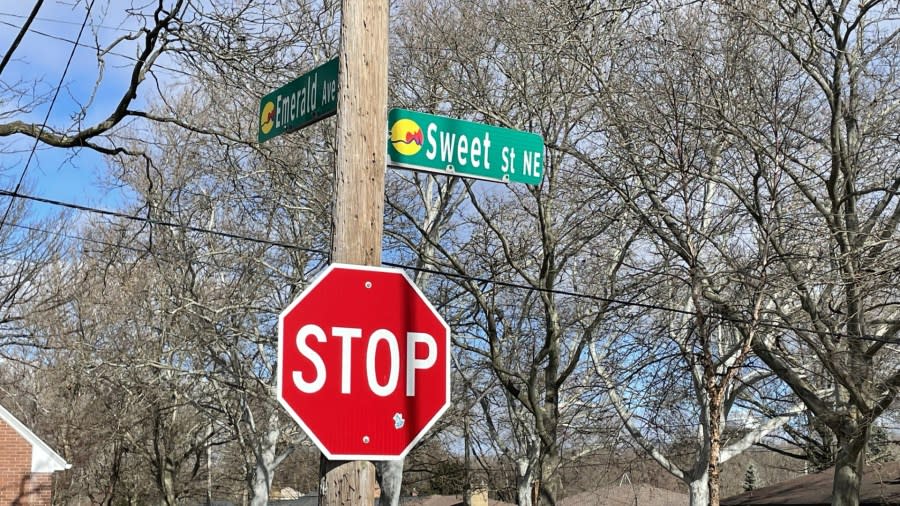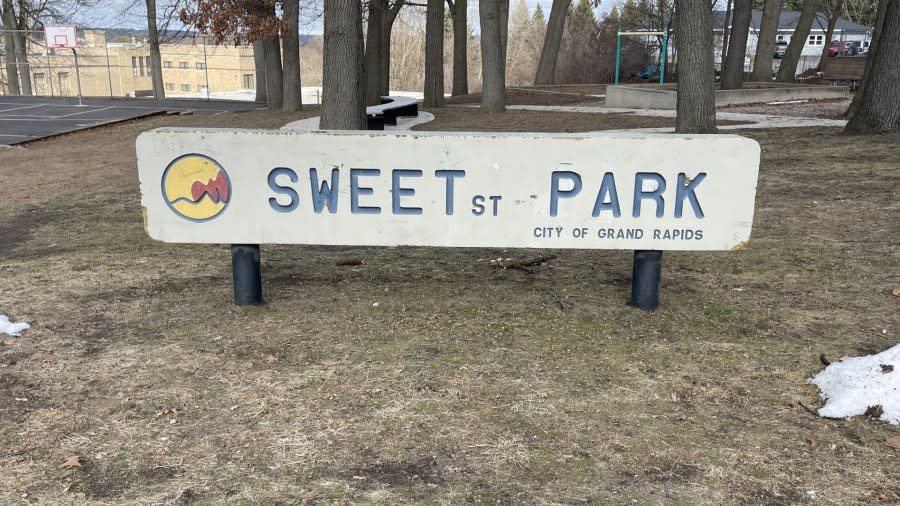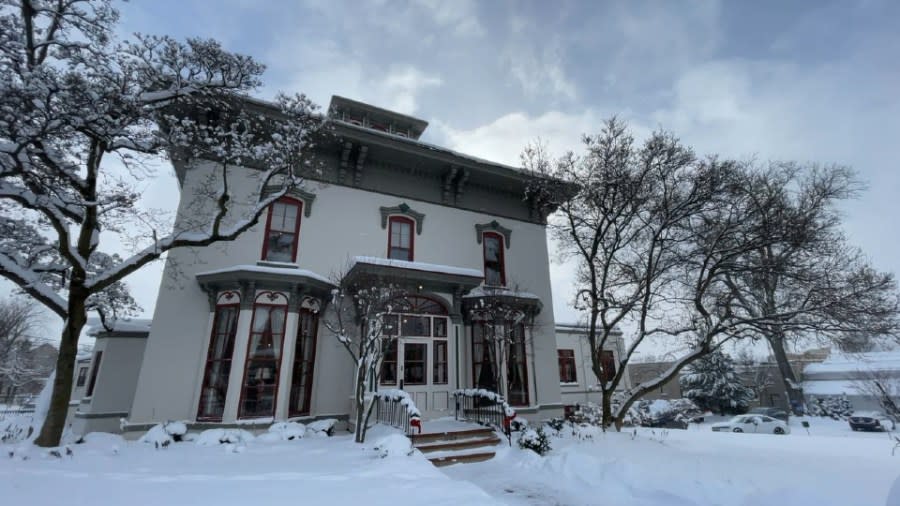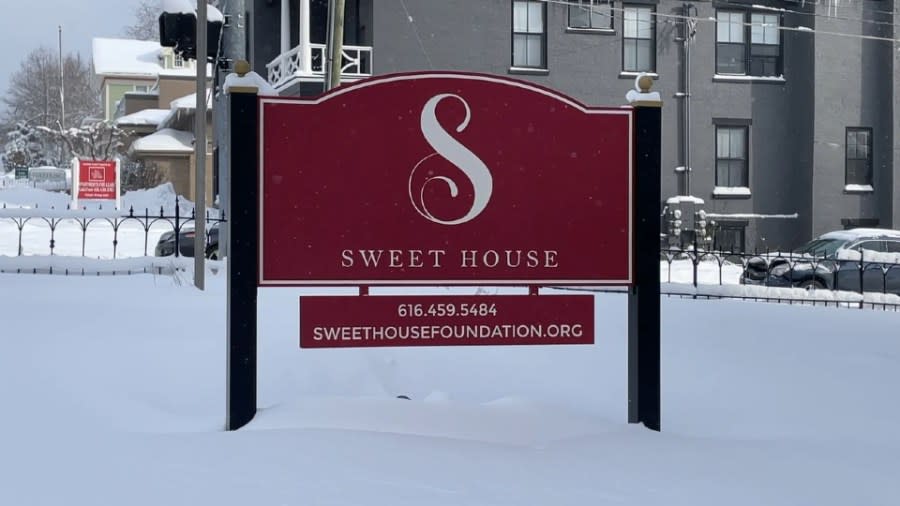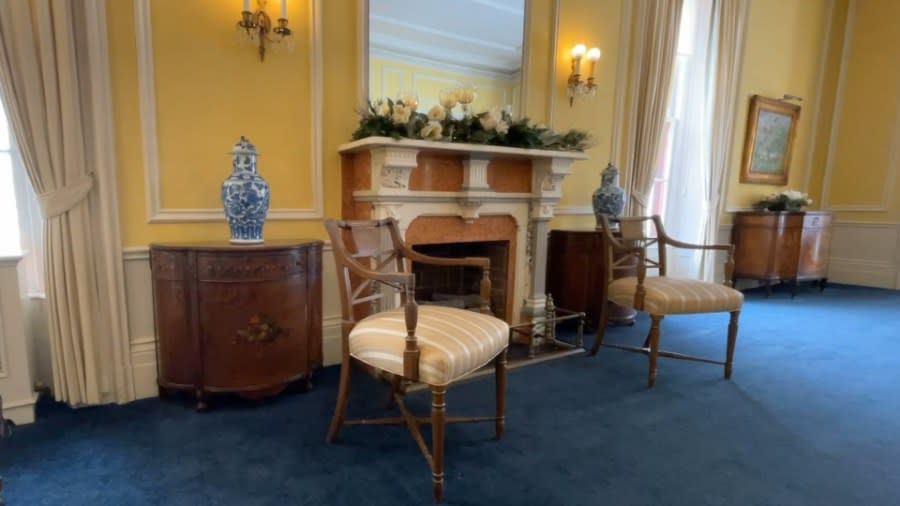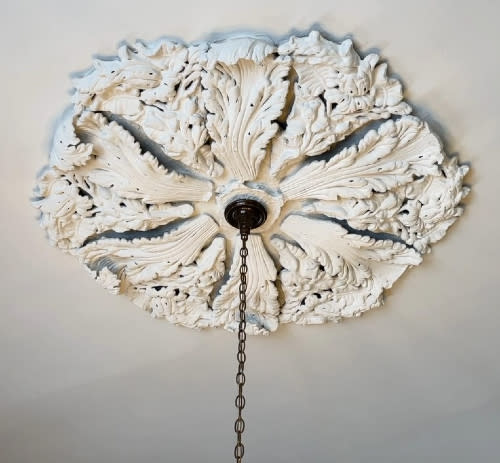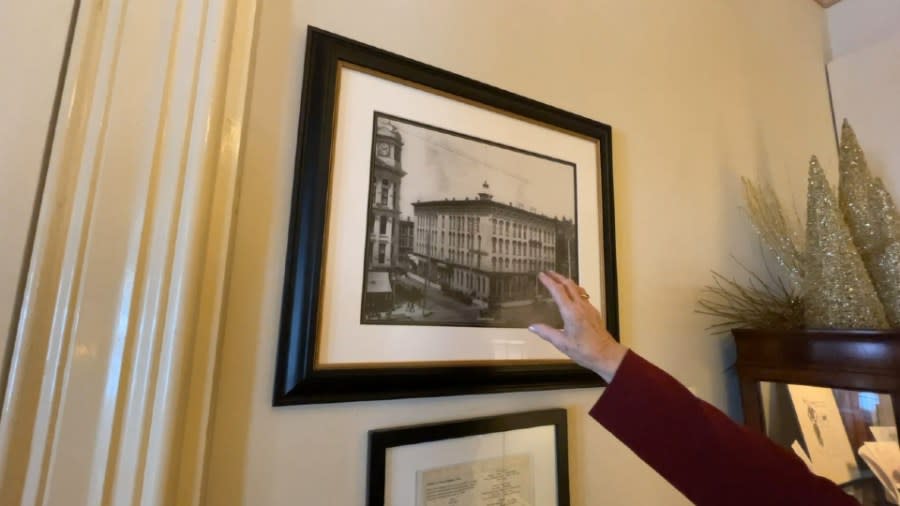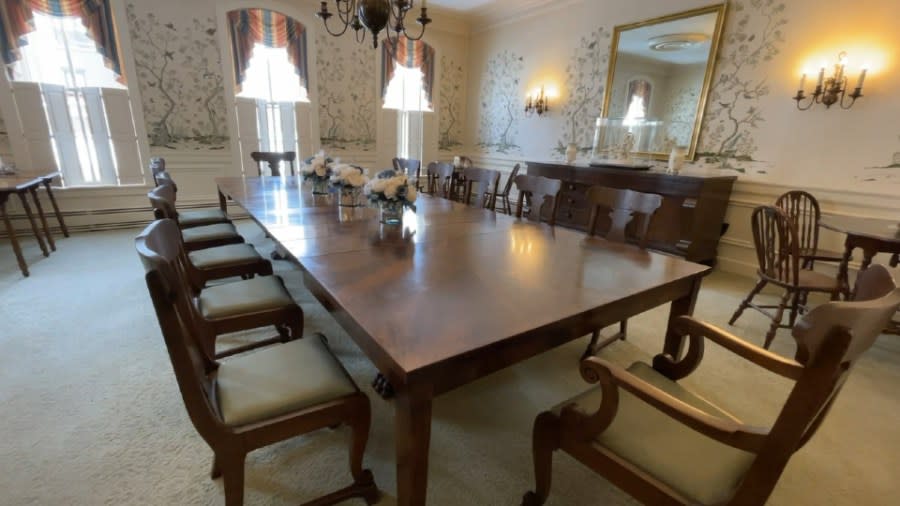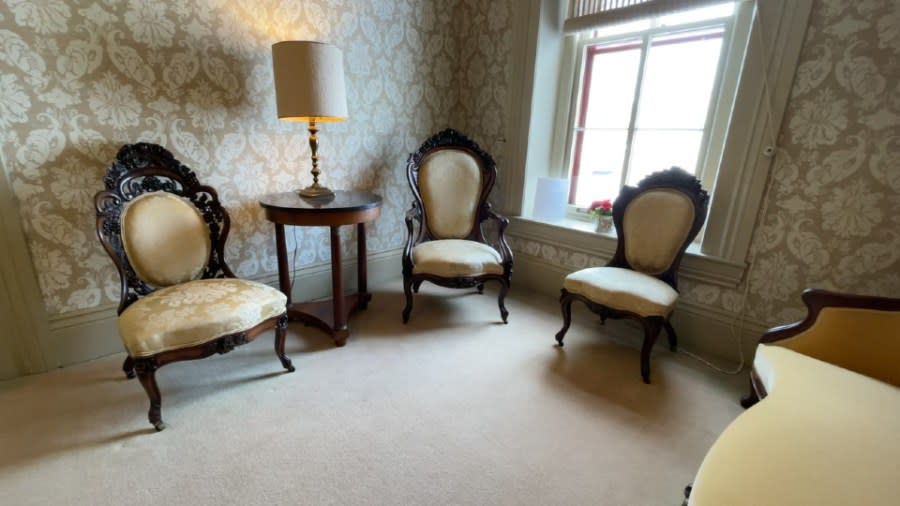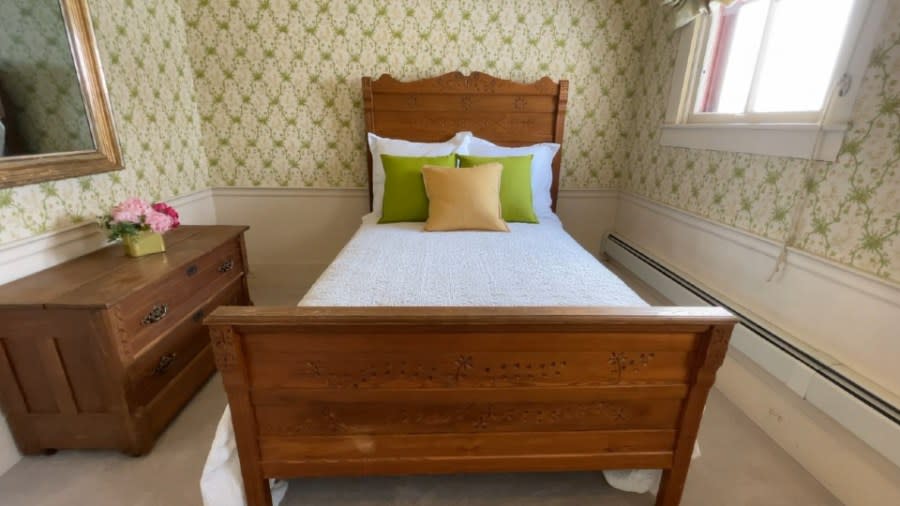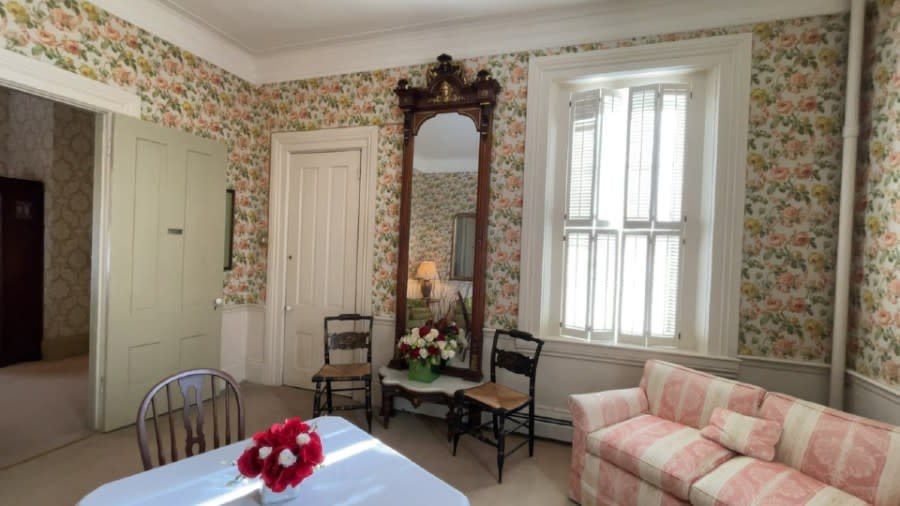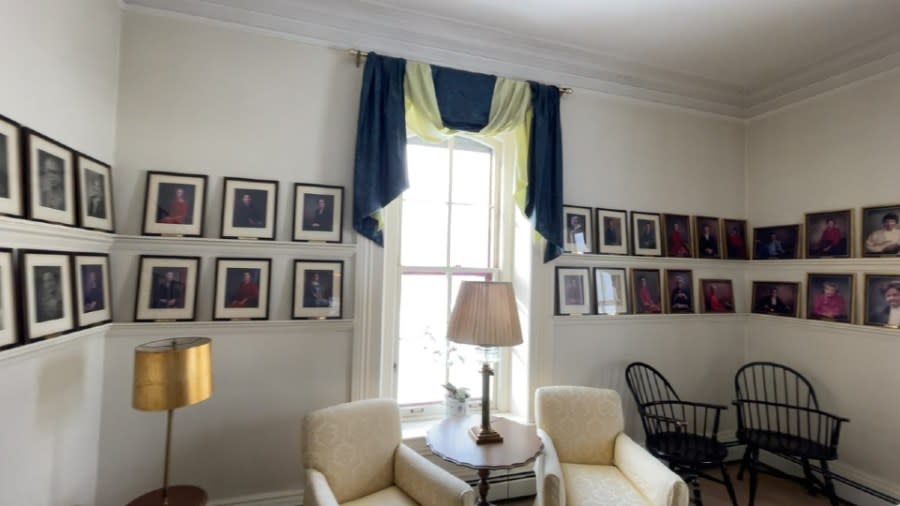The Sweet House: An inside look at a piece of Grand Rapids history

- Oops!Something went wrong.Please try again later.
- Oops!Something went wrong.Please try again later.
GRAND RAPIDS, Mich. (WOOD) — The Heritage Hill neighborhood is full of historic homes, but none stand out quite like the Sweet House.
The house is packed full of Grand Rapids relics: Paintings by West Michigan’s world-renowned artist Mathias Alten, a dining table that has served four U.S. presidents, even four gypsum medallions that celebrate a part of the city’s first industry. But the house itself is also a piece of history.
The Sweet House, which was built in the 1860s and still stands at the corner of East Fulton Street and Lafayette Avenue, is named after its first owner: Martin Sweet. Thanks to the work by the Grand Rapids Women’s City Club, which bought the building in 1927, it keeps his story and an era of life in the city alive.
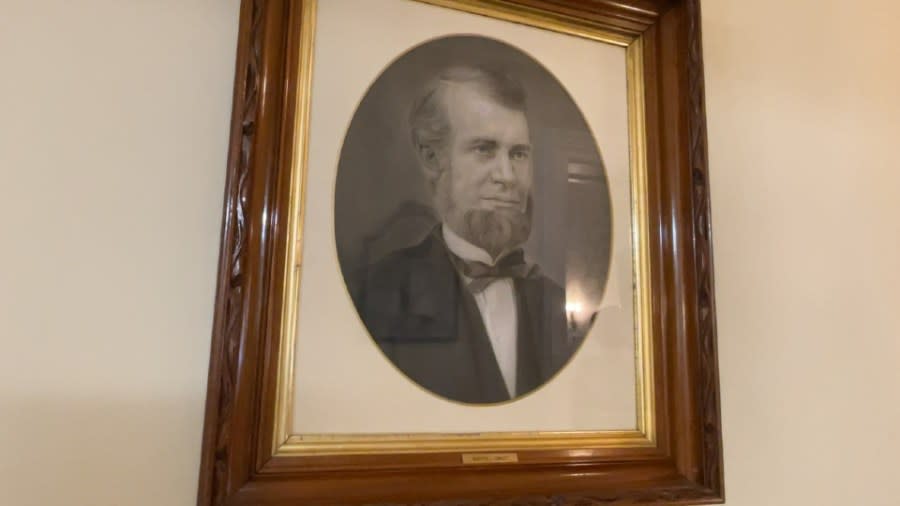
WHO WAS MARTIN SWEET?
Martin Luther Sweet was born in New York in 1819. The son of a miller, Sweet used the family trade to get himself established but used his dreams to carry him to riches.
Sweet had ventured away from New York multiple times, looking for his “land of opportunity.” He found it in Grand Rapids in 1846.
Carol Dodge, a former president of the Women’s City Club, is now the historian for the Sweet House Foundation. She wrote the book — literally — on the Sweet House. She says it was a mill that first caught Sweet’s eye.
“He was looking for the land of opportunity and the river was a real enticement because that meant power and transportation,” Dodge told News 8. “And there was a flour mill for sale right down where the post office is now. He bought that and then eventually built a larger mill. That started it all.”
Sweet wasn’t just a miller. He was a businessman. He built an empire, to the point where he was the wealthiest man in the city for a long stretch of time.
“He owned, that we know of, 19 businesses. And there probably are more. He was a true entrepreneur,” Dodge said.
Sweet was also a civil servant. He held several roles, even before making his big fortune. By 1850, he was elected as a city commissioner and was also the city supervisor for a year. He represented the city on the Kent County Board of Supervisors and in 1860, he was elected mayor. According to Dodge’s book, “The Mayor, The Maestro and The Mansion,” Sweet only served one term — one year — because he was simply too busy with his business dealings to dedicate himself to the job.
Sweet found success with his mills, but his empire took off after buying Daniel Ball’s failing bank in 1861. The M.L. Sweet & Company Exchange Bank proved to be a major success.
“It grew rapidly and continued to transact the general banking activities of the city until March 10, 1864, when, under the direction of several prominent businessmen, the bank merged with the First National Bank,” Dodge wrote. “Under Martin’s leadership, First National Bank prospered and served as the financial arm of the furniture industry that put Grand Rapids on the map.”
Tensions rising: What led up to the 1911 furniture worker strike
The roots of Sweet’s bank can still seen around West Michigan today. First National Bank eventually transitioned to Old National Bank. Long after Sweet’s death, Old National merged with the Kent State Bank to become Old Kent Bank. Old Kent was acquired by Fifth Third Bancorp in 2000.
In 1868, he decided to take on another business challenge, adding Sweet’s Hotel to his bank on the northwest corner of Monroe Avenue and Pearl Street. Sweet paid $150,000 for the hotel to be built, providing a first-class option to raise the level of luxury for Grand Rapids’ visitors. He owned the hotel until he mortgaged the property to pay for other business ventures in the 1890s. J. Boyd Pantlind bought the hotel in 1902 and used the land for his own luxury lodge. It is now known as the Amway Grand Plaza Hotel.
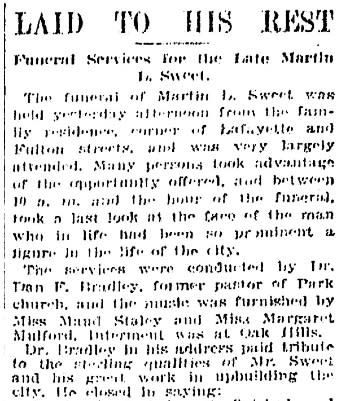
Business aside, Sweet also liked the simple life. He owned a farm on the northeast side of town where he raised cattle. A portion of that land is now the Kent Country Club. Sweet Street, which runs between Knapp and Leonard, is named in his honor.
Unfortunately, like all empires, Sweet’s eventually came to an end. Sweet, who used railroads to expand access across West Michigan, wanted to add a new line, but his financial maneuvering finally failed him in the 1890s.
“Martin believed that train transportation was needed from Lake Odessa to Coopersville. In the early 1890s, he mortgaged everything that he owned except his home to raise the money needed for a new company, the Lowell and Hastings Railroad, to build the tracks,” Dodge wrote. “Unfortunately, he went bankrupt during the 1893 depression, and the bank took possession of everything except the (Sweet House).”
He lived out the last years of his life at the Sweet House with his second wife, Emma McBrien Sweet. His first wife, Desdemona, passed away in 1890. According to newspaper records, in his final years, Sweet worked as a burner at the city garbage facility on a small salary. He passed away at his home on his 86th birthday, Feb. 21, 1905.
Sweet Street on Grand Rapids’ northeast side is named after Martin Sweet. The wealthy entrepreneur owned farmland near today’s Sweet Street. (Matt Jaworowski/WOOD TV8) Sweet Street Park, first built in 1972, is named after Martin Sweet. (Matt Jaworowski/WOOD TV8)
A HOUSE OF MUSIC
After Sweet’s death, his widow held onto the house for several years, eventually renting it out to be used as a music studio.
Clara Davis, one of the founders and president of the St. Cecilia Music Center, leased the Sweet House in 1911 to open a music school. Three years later, she invited Ottokar Malek to join her. His family eventually moved into the house and continued on with the Malek School of Music.
Malek’s journey to Grand Rapids was long and fraught. Born in Austria in 1875, Malek first started taking music lessons at 6 years old. Even as a child, he won awards for his performances and by the time he was 20, he had graduated from a conservatory with high honors.
The musician toured Europe as a concert pianist for several years, building a name for himself. He was one of Europe’s most sought-after musicians until 1902, when his life took a sudden left turn. While his career was thriving, his personal life fell apart when the love of his life confessed to cheating on him.
A newspaper article from the Hutchinson News in Kansas broke down his story.
“Malek was scheduled to appear that night at a concert in Berlin. In the rush of despair that swept over him when the realization of his beloved’s unfaithfulness smote his brain, he destroyed every letter, every token that would remind him of his unhappy love and boarded a vessel bound for America,” the article stated. “That evening, an expectant audience awaited breathlessly the appearance of the young pianist. They were doomed to disappointment.”
Sign up for the News 8 daily newsletter
Malek first moved to Chicago to stay with family that had immigrated there. Eventually, he returned to performing and made a name for himself in America. By 1911, Malek was traveling from Chicago to Grand Rapids once a week to give piano lessons. By 1914, he had made the move. Malek’s school offered a wide variety of classes, including piano, organ, violin and vocal lessons, filling the Sweet House with music.
After closing his school, he worked alongside the newly formed St. Cecilia Society to put together one of Grand Rapids’ first-ever civic orchestras, now the modern-day Grand Rapids Symphony. Malek led the symphony for three seasons before he died suddenly from pneumonia in 1923.
REVIVAL AND RENOVATION
In the years following Sweet’s death, the deed to the Sweet House changed hands several times. His second wife owned the home until 1913 when she deeded it to her children. According to Dodge, the house was sold to the Baptist Church Society in 1917 and then again to a family in 1922.
After the Malek School of Music closed in 1919, the home was used as a boarding house. Dodge says it fell into “terrible condition.” In her book, she quotes a 1971 speech by former WCC historian Dorothy Bean who detailed the issues within the house.
The ‘other’ mounds: Lost history is a part of West Michigan’s story
“The condition of the building was deplorable. (One account says) that the side porch on the Lafayette side held broken down rocking chairs and a wash kettle was there to catch drops from the leaking roof,” Bean said.
The work to repair and renovate the Sweet House started in earnest in 1927 when the Women’s City Club bought the house. Not only was the group committed to restoring the home, but they also wanted to expand it.
Contractors had to make adjustments to the floor plan to meet building ordinances. They had to replace the chimney, install a new heating system and add a second exit. Contractors also added two new large dining rooms as wings of the home and overhauled the lowest level to serve as an open meeting room.
The WCC celebrated its new clubhouse on May 10, 1928, with a gala. It held a second one 10 years later once the mortgage and debt for the renovations were finally paid off.
After being built in the 1860s, the Sweet House still sits at the corner of East Fulton and Lafayette Avenue. (Matt Jaworowski/WOOD TV8) The Sweet House sits at the corner of East Fulton and Lafayette Avenue in Grand Rapids. (Matt Jaworowski/WOOD TV8) The Sweet House’s “Best Room” is 16 by 33 feet, includes several paintings of Grand Rapids’ Mathias Alten and a giant marble fireplace. (Matt Jaworowski/WOOD TV8) The Sweet House still has four gypsum medallions that were installed when the house was built. (Matt Jaworowski/WOOD TV8) Carol Dodge references a black-and-white photo of Martin Sweet’s bank that sat at the corner of Monroe Avenue and Pearl Street. Sweet’s bank would eventually merge into a group that we now know as Fifth Third Bank. (Matt Jaworowski/WOOD TV8) The Sweet House’s “Wedgwood Room” holds a collection of mahogany furniture, including a giant dining table. (Matt Jaworowski/WOOD TV8) The Sweet House also owns four pieces of furniture designed by John Henry Belter, a designer known for his unique process of forming thin sheets of wood together and sculpted with ornate detail. (Matt Jaworowski/WOOD TV8) Two pieces of furniture made by the Martin L. Sweet Furniture Company are on display in the home’s former servants’ quarters. The dresser was donated to the organization in 2019. The matching bedframe was found at a garage sale in Zeeland in 2021. (Matt Jaworowski/WOOD TV8) A giant mirror that belonged to Desdemona Sweet now resides in the home’s upstairs parlor. The mirror used to sit in the front hallway so Mrs. Sweet could ensure she looked her best before heading out. (Matt Jaworowski/WOOD TV8) The Presidents’ Room inside the Sweet House holds portraits of all of the women who have served as the president of the Women’s City Club. The WCC called the Sweet House home for nearly a century. (Matt Jaworowski/WOOD TV8)
INSIDE THE SWEET HOUSE
Today, the home remains one of the jewels of the Heritage Hill neighborhood. The décor feels delicate and well-cared for. Though the WCC no longer calls the house its home, it still feels like a place where a group would settle down to play a game of cards or enjoy a glass of tea. And, most importantly, the halls of the foyer both include portraits of Martin Sweet and his first wife, Desdemona.
The “best room” — as the Sweets called it — has bright yellow walls, a royal blue carpet and several sitting areas, decorated with antiques and Alten paintings. It also holds one of the four gypsum ceiling medallions that signify the true age of the home.
“When the house was a boarding house, the best room was divided in half. It was two bedrooms. Fortunately, it didn’t damage the medallion in that room,” Dodge told News 8.
1883: The logjam that nearly sank Furniture City
The main level also holds the Wedgwood Room, a smaller dining room that features a giant mahogany table made by Berkey & Gay. The table and furniture were donated by Mrs. Samuel Lemon shortly after the WCC bought the Sweet House.
“Mr. Lemon was prominent in business and in the political community,” Dodge wrote. “He and Mrs. Lemon entertained many notable guests in their home, including three men who became president of the United States and dined with the Lemons at this table: William McKinley, Theodore Roosevelt and William Howard Taft.”
A fourth president, Gerald R. Ford, also dined at the table after it had been donated.
The upper level of the home features several unique treasures. On the second-floor landing sits four pieces of furniture designed by John Henry Belter, one of the most prominent furniture designers of the 19th century.
He developed a unique process using thin plies of wood held together with violin glue. Using steam and molds, he could bend and compress the wood into unique shapes while maintaining enough structural integrity to both carve them and use them as furniture.
Sign up for the News 8 weekly recap newsletter
The house has three Belter chairs and a sofa. Dodge called them “precious” but warns they aren’t very comfortable. The Sweet House Foundation no longer allows people to sit on them.
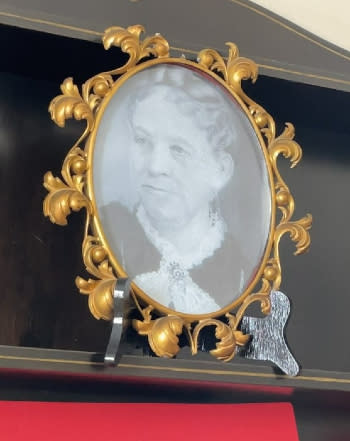
The former servants’ quarters are decorated with two pieces that didn’t belong to the Sweet family but were made at one of Sweet’s furniture companies. There is a dresser that was donated in 2019 and a matching bed frame that was acquired in 2021 after being spotted at a garage sale in Zeeland.
The parlor holds the one piece of furniture that actually belonged to the Sweets: Desdemona’s pier glass mirror. The mirror, framed in walnut with gilt leaf scrollwork, sits on top of a small, white marble table. Together, they stand 8 feet tall.
The mirror sits in the parlor now, but Desdemona Sweet had the mirror placed in the foyer.
“This was right by the front door so that before she went out, she could check herself out to make sure she (looked good),” Dodge said. “She was a real fashion plate. On Sundays, they went to Park Church, and people would line up outside … to watch Desdemona come out of the house to see what she would be wearing or her matching parasol or her boa.”
Paleoindians and beyond: West Michigan’s history goes back millennia
The Women’s City Club voted not to renew its lease at the Sweet House in 2018, officially leaving the building to the Sweet House Foundation. Now, the space is used as an events center, hosting weddings, showers and other meetings.
The house as a whole has a listed capacity of 300 people. Desdemona’s Dining Room can hold 125 people while the Hazel Vandenburg Ballroom on the lower level can hold up to 150. You can contact the Sweet House Foundation for more information.
You can get a copy of Dodge’s book, “The Mayor, the Maestro, and the Mansion”, through the Sweet House Foundation’s website.
For the latest news, weather, sports, and streaming video, head to WOODTV.com.
